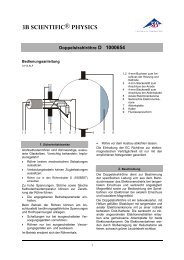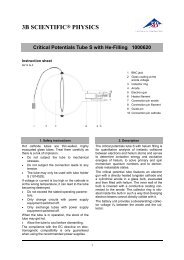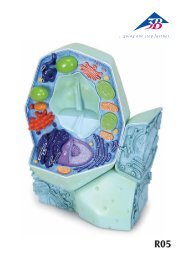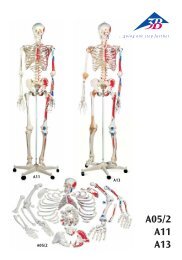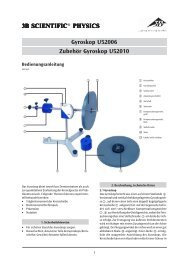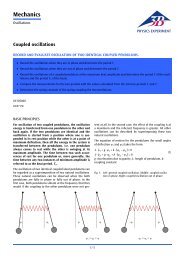La Célula Animal - American 3B Scientific
La Célula Animal - American 3B Scientific
La Célula Animal - American 3B Scientific
Create successful ePaper yourself
Turn your PDF publications into a flip-book with our unique Google optimized e-Paper software.
The <strong>Animal</strong> Cell<br />
and thus detoxifies them. In certain types of cell (e.g. muscle cells) the smooth ER also serves as a store for<br />
calcium ions.<br />
The Golgi apparatus (GA) consists of groups of flat sac-like membranes (sacculi) und numerous small<br />
vesicles. Here proteins newly synthesized in the ER are further modified. Specific sugar groups are synthesized<br />
and coupled onto proteins, and also some proteins are cleaved. In addition polysaccharides with<br />
appropriate sulfatization are synthesized and glycolipids are synthesized and joined together. These mature<br />
proteins are packed into vesicles in the GA and made ready for transport. Thus the GA plays an important<br />
role in the sorting and delivery of proteins (“Post Office of the cell“).<br />
The GA is also connected with exocytotic events (release of vesicles) and fagocytosis (protrusion of the<br />
plasma membrane with subsequent “pinching off” of the membrane together with the components that it<br />
surrounds). Vesicles can also be actively enveloped and captured (endocytosis) and also receptors acting as<br />
mediators can be brought in (pinocytosis). Membrane protrusions such as the microvilli (small finger-like<br />
protrusions with little mobility), stereocilia (larger protrusions with relatively little mobility) and kinocilia<br />
(flagellum-shaped protrusions for active cilia movement) will only be discussed in the course reading.<br />
Vacuoles can be formed both endocytotically and by cell components that digest the contents of vesicles<br />
(lysosomes).<br />
Alongside the lysosomes in a cell are small organelles (peroxisomes), which principally oxidize fatty acids,<br />
amino acids and uric acid and can detoxify potentially cytotoxic organic compounds.<br />
®<br />
Mitochondria are bacteria that entered unicellular organisms in primeval times and developed into socalled<br />
symbionts. They possess their own genetic material and also ribosomes for the synthesis of their<br />
own proteins. They have however become so intertwined with the genome of the host cell that they can<br />
no longer live independently. The benefit of this symbiosis is that the mitochondria can utilize oxygen (a<br />
principle toxic substance for living cells, that first arose in the primeval atmosphere from the evolution of<br />
plants). Thus carbohydrates, fatty acids and amino acids are oxidized to CO2 and H2O by consumption of<br />
elemental oxygen. In this way ATP, the universal energy carrier, is obtained for the cell. The mitochondrion<br />
possesses a double membrane wall. ATP synthesis and the processes of the respiratory chain take place on<br />
the internal wall itself. Fatty acid oxidation and the citric acid cycle take place within the mitochondria<br />
matrix. Thus the mitochondria can be described as the powerhouse of the cell.<br />
The cell nucleus is the information centre for the cell. The information itself is distributed over 46 deoxyribonucleic<br />
acid molecules (DNA). They are accommodated in the cell nucleus together with the histones<br />
(capping proteins). The nucleus is typically more densely packed than the cytoplasm and is surrounded by<br />
a nuclear double membrane (cistern of the ER) with defined channels (nuclear pores). The information for<br />
protein synthesis is taken to the ribosomes by the messenger ribonucleic acid (mRNA), which is synthesized<br />
on the gene segments of the DNA. This process is called transcription and produces copies of the DNA. The<br />
ribosomal RNA is synthesized on specialized segments in the nucleoli (aggregations in the cell nucleus). In<br />
addition there is close communication between the cytoplasm and the membrane receptors, so the cell<br />
nucleus represents the central information and control unit of the cell.<br />
Author: Prof. Dr. R.H.W. Funk, Institute of Anatomy, Dresden University of Technology<br />
English




